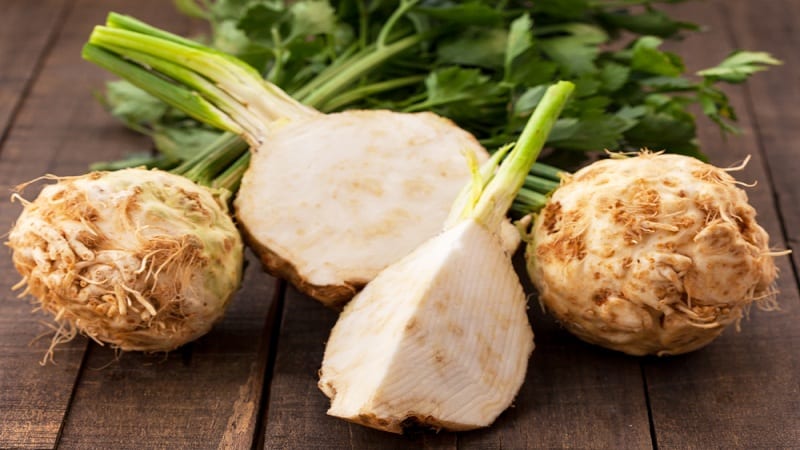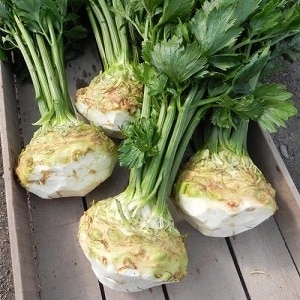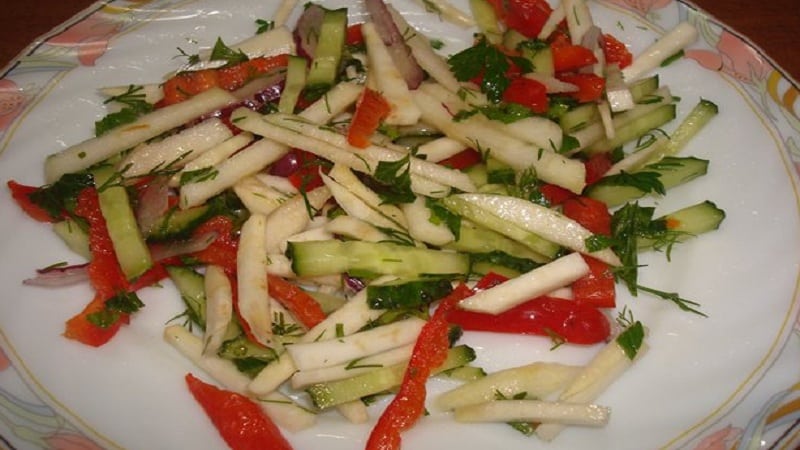What are the features of apple celery and why is it worth growing?
Apple celery is an old but proven variety of domestic selection, which appeared in the 60s of the twentieth century. The crop is grown for its root crops, but it is also suitable for forcing aromatic greens in winter.
Root vegetables have mass useful properties Due to their rich chemical composition, they are therefore widely used in cooking, folk medicine and home cosmetology.
Description of celery variety and origin
The variety was introduced into the State Register in 1961. It is suitable for cultivation in all regions of Russia, including the north, but the root crops are small in size.
Originators of the variety:
- CJSC Scientific and Production Company “Russian Seeds”;
- Association for Seed Growing of Vegetable Crops “Sortsemovoshch”;
- Agrofirm Aelita LLC;
- Intersemya LLC;
- Euro-seeds LLC.

The table summarizes the distinctive features of the variety.
| Indicators | Characteristic |
| Ripening period | 100–150 days |
| Keeping quality | 6–9 months |
| Socket | 20–25 leaves |
| Stems height | 50 cm |
| Root weight | Average - 150–200 g, maximum - 500 g |
| Form | Round, with many roots on the surface, diameter - 8–9 cm |
| Taste | Tart |
| Aroma | Nice |
| Color | White-gray |
| Productivity | 5–6 kg per 1 sq. m |
| Purpose | Tableware, medical, cosmetic |
| Sustainability | High |
Chemical composition, beneficial properties and harm
The table shows the vitamin and mineral composition of celery root (per 100 g).
| Substance | Content | Norm |
| Vitamin A | 3 mcg | 900 mcg |
| Beta carotene | 0.01 mg | 5 mg |
| Vitamin B1 | 0.03 mg | 1.5 mg |
| Vitamin B2 | 0.06 mg | 1.8 mg |
| Vitamin B4 | 9 mg | 500 mg |
| Vitamin B5 | 0.4 mg | 5 mg |
| Vitamin B6 | 0.15 mg | 2 mg |
| Vitamin B9 | 7 mcg | 400 mcg |
| Vitamin C | 8 mg | 90 mg |
| Vitamin E | 0.5 mg | 15 mg |
| Vitamin H | 0.1 mcg | 50 mcg |
| Vitamin K | 41 mcg | 120 mcg |
| Vitamin PP | 1.2 mg | 20 mg |
| Potassium | 393 mg | 2500 mg |
| Calcium | 63 mg | 1000 mg |
| Silicon | 29 mg | 30 mg |
| Magnesium | 33 mg | 400 mg |
| Sodium | 77 mg | 1300 mg |
| Sulfur | 15 mg | 1000 mg |
| Phosphorus | 27 mg | 800 mg |
| Chlorine | 13 mg | 2300 mg |
| Iron | 0.5 mg | 18 mg |
| Iodine | 0.4 mcg | 150 mcg |
| Cobalt | 1.8 mcg | 10 mcg |
| Manganese | 0.158 mg | 2 mg |
| Copper | 70 mcg | 1000 mcg |
| Molybdenum | 4 mcg | 70 mcg |
| Selenium | 0.7 mcg | 55 mcg |
| Fluorine | 4 mcg | 4000 mcg |
| Chromium | 2.4 mcg | 50 mcg |
| Zinc | 0.33 mg | 12 mg |
Useful properties of celery:
- relieving inflammation;
- prevention of cancer;
- removal of toxins, radionuclides, nicotine, alcohol, drugs;
- immune support;
- regulation of the gastrointestinal tract;
- increased sexual desire;
- strengthening the walls of blood vessels;
- normalization of blood pressure;
- lowering cholesterol levels;
- increased hemoglobin;
- elimination of allergies;
- mild laxative effect;
- general toning of the body;
- reduction of swelling;
- memory improvement;
- prevention of Alzheimer's disease;
- regulation of metabolism;
- rejuvenation of the body;
- reducing the level of carcinogens;
- regulation of the menstrual cycle;
- reduction of unpleasant symptoms of menopause.
Celery root is recommended to be used with caution by pregnant and lactating women, people suffering from varicose veins, stomach and duodenal ulcers.
Celery agricultural technology
The rules for cultivating root celery provide for timely sowing of seeds for seedlings, picking, planting in the ground, watering and fertilizing.
Sowing seedlings
To grow root celery, the seedling method is used due to the low percentage of seed germination and the long growing season of the plant. Sowing work begins at the end of February or early March.
Before sowing, the seeds are stratified: wrapped in damp gauze and left at room temperature for a week, then placed in the refrigerator for 12-14 days. In this way, natural conditions are created when the seeds overwinter in the ground and sprout in spring.
The seed is planted in specially prepared soil from garden soil, river sand, peat, sunflower seed husks, and crushed eggshells. The components are mixed in equal proportions and disinfected in the oven or spilled with a strong infusion of potassium permanganate. For every 10 kg of substrate take 20 g of urea and 200 g of wood ash.
Before sowing, the soil is abundantly moistened with clean water at room temperature and the grains are planted to a depth of 5 mm. Watering is carried out as the top layer of soil dries. After 14 days, preventive spraying is carried out with Trichodermin (10 mg per 1 sq. m).
Until the sprouts appear, the boxes are kept under a film cover in a dark room at a temperature of +20...+22°C, then transferred to a lighted place.
Seedling care
After the first leaves appear, the temperature is reduced to +12...+16°C, and after 10 days it is increased to +20...+25°C. Strong seedlings with 3-5 leaves are dived into separate containers, choosing the strongest specimens.
For transplantation, use separate cups with a diameter of at least 6 cm. Holes are made in the bottom to drain excess water. The container is filled with the same substrate that is used for planting, a depression of 2-2.5 cm is made, and watered with a syringe.The seedlings are carefully dug up with a wooden peg and placed in the hole. Sprinkle soil on top, leaving the cotyledon leaves on the surface. Then the plants are watered with clean, settled water and fed with “Gumi” at the rate of 6 drops per 1 liter of water.
After picking, the seedlings are left in a dark place for 2-3 days to reduce stress, then taken out into sunlight. If necessary, the sprouts are illuminated with a phytolamp. The norm of daylight hours for root celery is 12-14 hours. The optimal air temperature is +18…+22°С.
Watering the seedlings is carried out 1-2 times a week, adding Fitosporin-M. The soil is loosened with a peg, trying not to touch the roots.
Seedlings are fed according to the following scheme:
- 14 days after sowing - chicken manure (1 tsp per 3 liters of water);
- subsequent feedings are carried out every 10 days - “Nitrophoska” and chicken manure in turn (1 tsp per 3 liters of water).
3 weeks before planting in the ground, the seedlings are taken out into the open air in partial shade.
Landing in the ground
Apple celery seedlings that have reached 20–25 cm in height are transplanted into open ground in the third ten days of May.
Light sandy loam soil rich in humus and open sunny areas are suitable for growing the crop. The predecessors of the plant can be any vegetables. In the fall, the area is dug up and fertilized with humus - 10 liters per square meter. m.
In the spring, the beds are dug up to a depth of 30 cm, and the ground is sprayed with a solution of potassium permanganate or copper sulfate.
Seedlings are planted to a depth of 10 cm, according to a 20x20 cm pattern, or between beds of garlic, onions, potatoes, and cabbage. Vegetables love this kind of proximity. The strong aroma of celery repels harmful insects. After transplanting, water the soil abundantly.
Care
Rules for caring for plantings:
- Watering. The beds are moistened moderately, keeping the soil constantly moist, but do not overwater. The frequency of moistening depends on weather conditions. Watering should be carried out strictly at the root, adding nettle infusion to the water (1 tbsp per 10 l). To prepare the infusion, nettles are crushed and infused in water for 2 weeks.

- Mulching. Covering the area with sawdust, hay or straw retains moisture and prevents the growth of weeds.
- Loosening and weeding. Care procedures are carried out once every 2 weeks. After the root crop has increased in size, the soil is raked off, the root part is freed and the lateral roots are trimmed.
- Feeding. Root celery is fertilized with an infusion of chicken manure (in a ratio of 1:15) 14 days after planting in the ground and with superphosphate (25 g per 10 l) in the last days of July. If the leaves are pale, prepare a solution of urea (10 g per 2 liters of water).
- Tops. The leaves of root celery are not cut off, otherwise the root crop will not receive sufficient nutrition and will ripen small.
Diseases and pests
The Apple variety is resistant to most crop diseases - viral mosaic, white rot, blackleg.
To protect plants, it is enough to follow the following preventive measures:
- regular weeding;
- moderate watering;
- crop rotation;
- timely application of mineral fertilizers.
To repel insects - slugs and carrot flies - biological products and folk remedies are used. Chemicals are banned because toxic substances accumulate in roots and leaves.
The best biological products:
- "Gapsin";
- "Fitoverm";
- "Bitoxibacillin";
- "Lepidocide";
- "Boverin";
- "Verticillin".
Slugs are gotten rid of by hand picking at night or spraying the plantings with a solution of ammonia - 2 tbsp. l. for 10 l.
Carrot flies are repelled by:
- ammonia solution - 2 tbsp. l.for 10 l;
- saline solution - 1 tbsp. l. for 10 l;
- onion peel solution - 400 g per 5 l;
- infusion of orange peels - 1 kg per 10 l;
- sprinkle the beds with tobacco dust, ground red pepper or mustard powder.
Harvest and storage
The readiness of celery for harvesting is determined by the leaves. Yellowing of the greenery indicates that the root crop has stopped growing and has reached technical ripeness.
24 hours before harvesting, the beds are moistened abundantly to make it easier to remove the root crop from the soil. Celery is pulled out from soft and loose soil by pulling the top. If the soil is dense, pry up the roots with a pitchfork or shovel. The tops are cut off, the dirt is shaken off and left to dry in the open air.
Damaged specimens are used first because they deteriorate quickly.
Celery is stored in a basement or cellar at a temperature of +2...+8°C.
Uses of apple celery
Celery root is widely used in cooking. It goes well with apples, carrots and dressings in the form of yogurt, sour cream and vegetable oil. The root is prepared for future use in the winter - frozen into cubes and dried.
Root vegetables are added to salads, first courses, stewed, baked, and served as a side dish for meat and fish.
In folk medicine, celery is used to treat the gastrointestinal tract, liver, pancreas, urolithiasis, and gout. An infusion is prepared from the root and the juice is squeezed out.
In cosmetology, celery has established itself as an excellent remedy for toning, cleansing and brightening the skin.

Recipes
To prepare a mild laxative, take 1 tbsp. l. root crushed into pulp, put in a thermos and pour 300 ml of boiling water. Leave for 3-4 hours and take 1 tbsp before meals. l.
To increase potency, fresh juice is used. The root is crushed in a blender and the juice is squeezed out or passed through a juicer. Take 1-2 tsp. 30 minutes before meals.
To prepare a vitamin face mask, mix 1 tbsp. l. grated root, oatmeal, grated apple. The mixture is applied to clean skin, kept for 20 minutes, and washed off with warm water.
A lot of tasty and healthy dishes are prepared from celery root. We suggest adopting recipe vitamin salad for losing weight with dietary dressing.
Ingredients:
- bell pepper - 1 pc.;
- cucumber - 1 pc.;
- celery root - 150 g;
- parsley - 1 bunch;
- apple - 2 pcs.;
- 0.5% yoghurt - 200 ml.
A 100 g serving contains 40 kcal.
Preparation:
- Wash the pepper, remove the seed box and tail, cut into strips.
- Peel the apples, remove the seeds and cut into cubes.
- Cut the fresh cucumber into strips.
- Peel the celery and grate it using a Korean carrot grater.
- Season the salad with yogurt mixed with salt and finely chopped parsley. Instead of yogurt, you can use olive oil and lemon juice.
Advantages and disadvantages
Why Apple celery root is valued:
- with proper care from the moment of sowing, seedlings grow strong and healthy;
- plants can withstand frosts down to –5°C;
- gets along in garden beds with other crops (cabbage, beets, potatoes, tomatoes, cucumbers, beans, peas);
- has a long shelf life;
- transfers transportation over long distances;
- used in cooking, cosmetology, folk medicine;
- contains a large amount of fiber (1.8 g per 100 g);
- has low calorie content (42 kcal per 100 g);
- The variety is resistant to viral and fungal diseases.
Disadvantages of culture:
- the plant needs to comply with the normal daylight hours;
- has a specific taste and aroma that not everyone likes;
- long growing season;
- low seed germination;
- does not like waterlogging of the soil, responding with rotting and death;
- in the northern regions it is not possible to grow large root crops.
Reviews
Despite the claims of the originators about the ease growing Apple varieties, gardeners face some difficulties.
Inna, Voronezh: “Last year I planted Apple root celery. In the picture, the root crop looked attractive, but in reality, a sponge was pulled out of the ground from the roots. I only used foliage, and it was quite tough. Later I read on one forum that it was necessary to feed the plant with organic matter and minerals every 10 days, alternating. I don’t risk planting again for now.”
Ivan, Kursk: “I heard a lot of negative reviews about the Apple variety, but it grows for me without problems. The root vegetables, of course, are not the same as in the picture, but quite large, more elongated in shape. There is an important nuance when growing root celery, which many people forget - you need to rake out the soil after the root crop has formed and cut off the lateral roots. Then the celery will grow large. Some gardeners wipe small roots with a cloth.”
Conclusion
Apple celery is demanding to care for, but if you follow the rules of agricultural technology, you can harvest a good harvest - about 6 kg per 1 square meter. m. It all starts with pre-sowing preparation of seeds and growing seedlings. At this stage, due attention is paid to caring for the seedlings, providing long daylight hours, sufficient watering and fertilizing with organic matter and minerals.Having transplanted the seedlings into the ground, weed and loosen the soil after each watering, fertilize the plantings with chicken manure and “Nitrophoska” (superphosphate), and remove the side roots from the root crops.
Celery is used to prepare a variety of dishes, included in menus for weight loss due to its low calorie content, infusions and juice are prepared for the treatment of the gastrointestinal tract, liver, pancreas, masks for toning and whitening the skin.